Main caliber of the Russian Imperial Navy
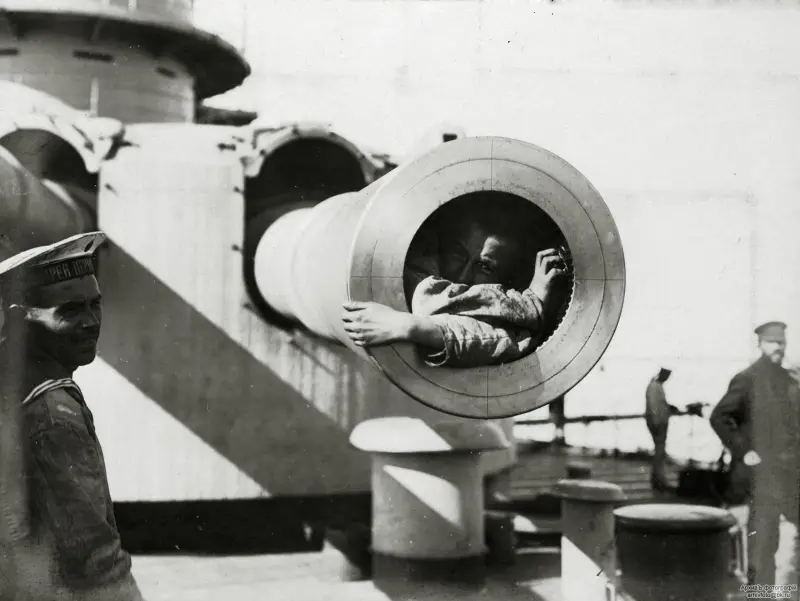
In the proposed series, I will provide the dear reader with a description of some aspects of the evolution of domestic twelve-inch armor-piercing and high-explosive shells in the period 1877–1911. As well as armor-piercing tips, which were tested in the Russian Empire starting in the 90s of the 152th century, but were first used to equip part of the ammunition (a certain number of 2-mm shells) of the ships of the XNUMXnd Pacific squadron leaving for Tsushima.
Armor-piercing shells
According to the textbook (we are talking about the 30s of the last century), an armor-piercing projectile is such a projectile in which the design of its body and specially its head part (with corresponding hardening) achieves the greatest possible armor-piercing qualities. Moreover, the high-explosive action is used only to the extent permitted by the drawing, without prejudice to the full satisfaction of its main purpose.
Obviously, the body of an armor-piercing projectile must be as strong as possible. In this case, it would seem that the ideal armor-piercing projectile should be a steel blank, consisting entirely of metal and not having an internal void for placing explosives (explosives) in it. Of course, German armor-piercing shells of the late 19th century immediately come to mind, which were exactly that. But such a conclusion, despite all its apparent logic, will be erroneous.
The fact is that the strength of steel depends, among other things, on heat treatment, and the best quality of the latter is precisely achieved in the presence of that same internal void - due to more uniform heating of the workpiece. Therefore, the body of an armor-piercing projectile with an explosive content of up to approximately 3% was stronger than a solid projectile of the same caliber and weight, containing absolutely no explosives, but a further increase in the charge had a negative effect on the strength of the projectile.
A little about domestic twelve-inch cameras
As you know, the 2nd half of the 508th century was marked by many achievements of scientific and technological progress, including: a massive transition to breech-loading rifled guns. Following new trends, in their native Fatherland they decided to equip the new battleship “Peter the Great” not with cyclopean XNUMX-mm muzzle-loading and smooth-bore monsters, as was intended in the original project, but with artillery systems of the latest design.
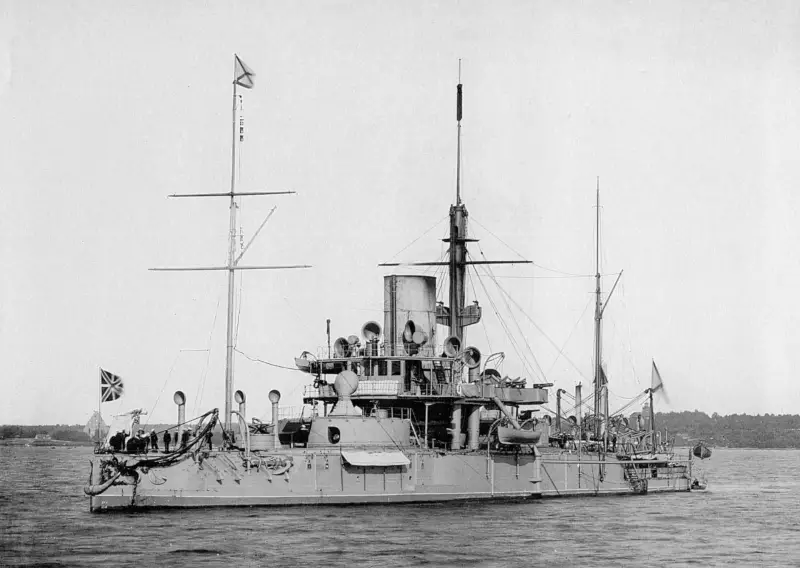
It must be said that when designing land and naval artillery, our engineers took, perhaps, the best path possible. In 1858–1861 In Russia, guns from almost all leading foreign manufacturers were tested, and, of course, guns of our own production.
According to the results of the experiments, the American and English guns were considered very unsatisfactory: both range and accuracy were lame, but the products of the Krupp plant turned out to be beyond praise. That is why it was decided that the Krupp design had the best prospects, which was adopted as the basis for all domestic developments.
Obviously, this decision also indicates that the first domestic artillery systems were inferior to Krupp guns. However, the German experience was not absolute: in the Russian Empire the search for the best solutions and numerous tests of various innovations in artillery continued, both in terms of the design of the gun and in terms of the gunpowder that made up the charges for it.
Accordingly, when the question of organizing the production of large-caliber naval guns arose, Russia had already accumulated its own considerable experience, which was quite successfully combined with German experience. Simply put, ours acquired an 11-inch Krupp gun and modified it, resulting in 280-mm and 305-mm guns mod. 1867. These guns were produced according to our drawings, which were somewhat different from Krupp’s, and, it must be said, they turned out to be very, very successful for their time.
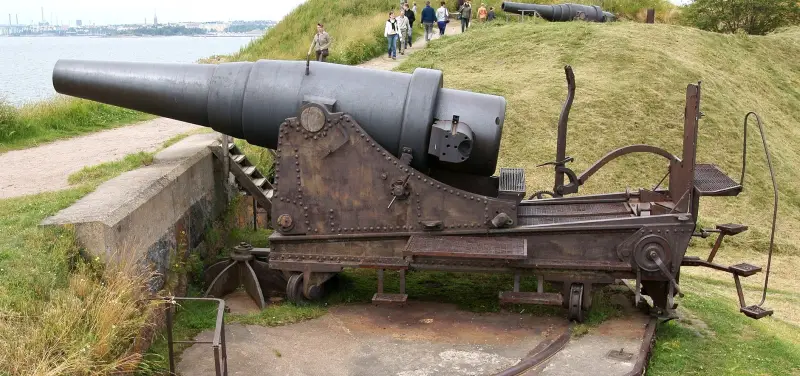
280 mm gun mod. 1867
So, for example, a 280-mm gun of domestic production fired shells weighing 520 pounds (212,95 kg), like the German one, but for our guns the charge was 100 pounds of gunpowder, while for the German ones it was 91,5 pounds. At the same time, a firing test showed that even after 500 (five hundred) shots the gun had such minor damage that it could continue to serve, and it was installed on the gunboat “Ruff”.
The twelve-inch gun, according to the information I have (alas, not exhaustive), was created by our engineers by scaling the 11-inch Krupp, with a change in the location and size of the rings holding the barrel together, and, possibly, other modifications. Since 1873, six 305 mm/20 guns mod. 1867: four for the battleship “Peter the Great” and two for the Black Sea “popovka” “Kyiv”.
But no matter how good the first domestically produced twelve-inch was, it quickly became outdated - progress in those years moved forward by leaps and bounds. Work on gunpowder, metal and the design of artillery systems made it possible to move on to the production of so-called “long-range” guns, achieving a significant increase in the initial speed of the projectile and its flight range.
The new twelve-inch gun, also based on a 280-mm German gun (but more modern), received a barrel extended to 30 calibers. The first copy of the 305 mm/30 artillery system mod. 1877, was ready in 1880. These guns were adopted by battleships of the “Ekaterina II” and “Alexander II” types, as well as the non-serial “Gangut” and “Twelve Apostles”. The latter, as is known from reliable sources, later together with the “Three Saints” formed the striking fist of the Black Sea fleet among fifteen battleships.
The next step was the 305 mm/35 gun mod. 1886. I must say that story the creation of “35-caliber” twelve-inch guns is very interesting, and I will return to it, albeit a little later. Following it came the turn of the famous “butt” - a 305 mm/40 gun model 1895. It was the most advanced twelve-inch Russian naval gun of the pre-dreadnought era, but, alas, far from the best weapon of this caliber in the world.
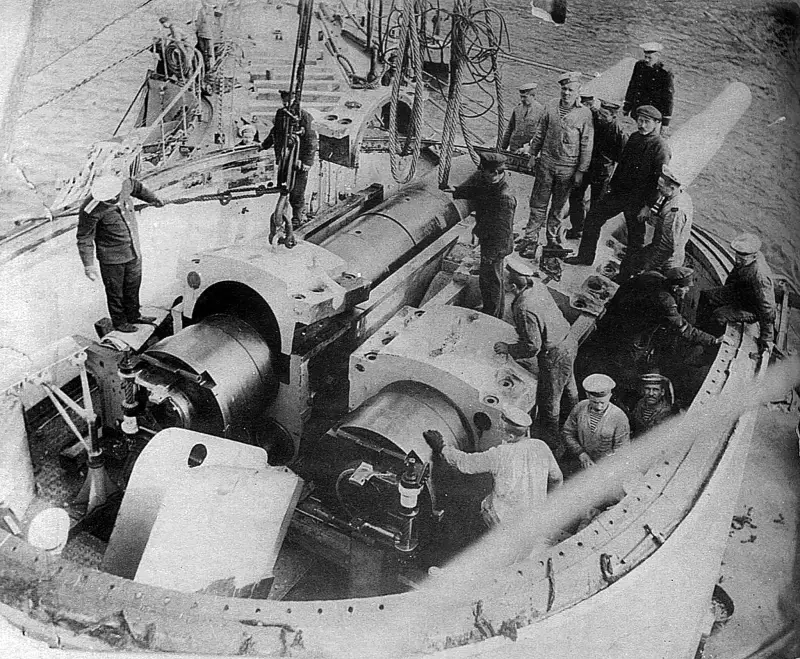
305 mm/40 gun mod. 1895 in the tower of the squadron battleship "Tsesarevich"
The crowning achievement of the development of twelve-inch guns in the Russian Empire was the 305-mm/52 gun mod. 1907, installed on dreadnoughts of the Sevastopol and Empress Maria types. This gun was truly at the level of the world's best examples, and could well lay claim to the title of the best artillery system of its caliber during the First World War.
This marked the end of the evolution of domestic twelve-inch naval guns. In the USSR, they returned several times to the creation of 305-mm cannons, which, due to their characteristics, should have left the Tsarist twelve-inch guns far behind, but it did not work out: neither for the heavy cruisers of Project 69, nor for the post-war project “Stalingrad”.
305 mm armor-piercing shells - mass and explosive content
Of course, the latest for its time, 305 mm/20 guns mod. 1867 demanded the latest shells, and they tried to create them. Alas, the first pancake turned out to be lumpy.
It is quite obvious that ordinary cast iron bombs, used as ammunition for smooth-bore guns, could not possibly fulfill the role of an armor-piercing projectile. Accordingly, our gunsmiths made a steel armor-piercing projectile, but it was too expensive. Then they tried to experiment with different hardenings of cast iron, but, of course, no tricks could give the “cast iron” the required strength. I had to come to terms with the rising cost of ammunition, but another problem arose.
The fact is that both hardened cast iron and steel armor-piercing shells were equipped with a powder charge, the rupture of which in all tests for some reason occurred in the process of penetrating the armor. Moreover, apparently, at the moment of contact with the plate, since the shells were destroyed during the explosion and, although they left significant potholes, they did not penetrate the armor at all.
Unfortunately, I was unable to figure out what exactly went wrong. Perhaps it was the operation of the fuse. But, whatever the problem, it was not possible to solve it at that moment, and the ammunition load of 305 mm/20 guns mod. 1867, in addition to cast iron high-explosive bombs, included steel armor-piercing shells that did not contain any explosives. As for the mass of these shells, in the publications known to me it is indicated differently: from 306 to 321 kg.
Armor-piercing projectile for the next 305 mm/30 gun mod. 1877 was already different. Its mass is known exactly and is 810 pounds or 331,7 kg (Russian pound - 0,40951241 kg). It is also reliably known that this armor-piercing projectile was equipped with explosives, but I was unable to find out how many explosives were placed in it.
It is noteworthy that the mass of shells for 305 mm/30 guns mod. 1877 corresponds to the later “lightweight” shells of the Russian Navy, with which our squadron battleships fought at Shantung and Tsushima. But if for 1895–1905. a twelve-inch 331,7 kg projectile would rightfully be called lightweight, but 17 years earlier, and even in the first half of the 1890s, it was not such.
British battleships accepted by the fleet in the second half of the 1880s (even the lead Collingwood of the “Admiral” series) carried 305 mm/25 guns firing 325 kg shells. The twelve-inch Krupp guns mounted on the Dingyuan-class battleships destined for China carried shells weighing 329 kg (although there are different opinions, this weight seems to be the most realistic). The French, on their battleships Charles Martel, carrying two 305-mm guns, made do with ammunition weighing 292 kg.
In other words, at the time of the creation of the 305 mm/30 gun mod. 1877 Russian shell was one of the heaviest twelve-inch shells in the world.
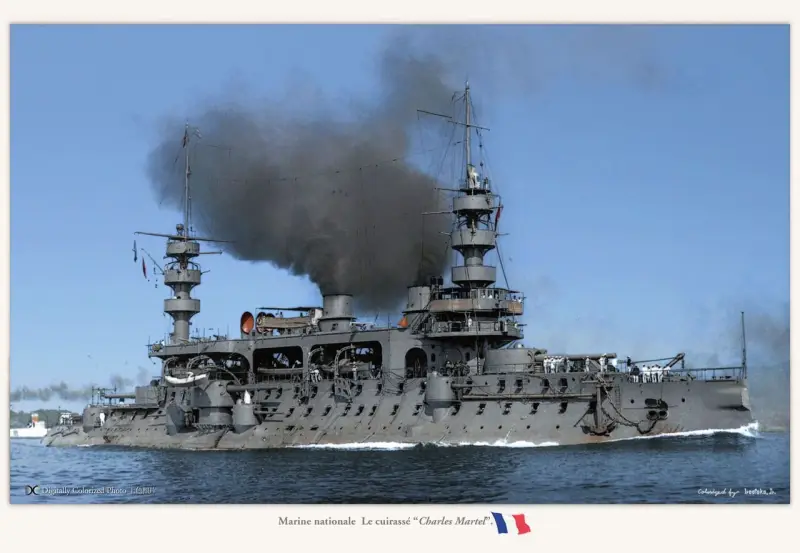
Alas, having taken the first step so successfully, we stumbled on the second. Black powder, which Russian shells were loaded with in those years, had a very limited explosion force, and obviously not much could fit into a 331,7 kg armor-piercing projectile. Hence the relatively small armor effect, and, of course, the sailors wanted more.
“Be afraid to dream, dreams sometimes come true.” As many as 1-pound (111 kg) projectiles were created. Heavyweight record holders, which in those years not a single twelve-inch projectile in the world came close to. It was assumed that the new 454,97 mm/305 gun mod. 35 can be made much more durable than the 1886 mm/305 mod. 30, accordingly, it will be possible to increase the pressure in the barrel and give the new armor-piercing projectiles a high initial velocity, ensuring confident defeat of the enemy at all reasonable (at that time) combat distances.
Unfortunately, the possibilities of scientific and technological progress turned out to be overestimated. It was assumed that the new gun would be able to fire 454,97 kg projectiles with an initial speed of 2 feet per second (almost 000 m/sec), while the pressure in the barrel was supposed to reach 610 atm. However, with such pressure, after the fiftieth shot, the accuracy ceased to be any real. By reducing the initial speed to 3 f./s (000 m/s), it was possible to obtain an acceptable barrel life, but this speed was considered too low and did not provide the required armor penetration.
And here our decision-makers should have drawn the right conclusions by creating an “intermediate” projectile weighing 380–390 kg, which would provide acceptable values for barrel survivability, initial velocity and explosive mass in high-explosive and armor-piercing projectiles. But, unfortunately, this did not happen.
When developing technical specifications for the design of a new 305-mm/40 gun mod. In 1895, completely different requirements were established. The first was quite reasonable - to ensure the survivability of the barrel for at least 150 shots without a critical loss of accuracy. But the second - a significant reduction in the weight of the gun, apparently, was dictated solely by ideas of economy, since, according to some, albeit indirect, data, the pricing of a gun in those years depended on its mass. This is nothing more than a hypothesis, but I cannot give any other reasonable explanation for this phenomenon: I will be happy to listen to the opinions of knowledgeable readers on this matter.
So, against the background of these requirements, a return to 810-pound (331,7 kg) shells suggested itself. Moreover, at short combat distances, lightweight shells actually had an advantage in armor penetration over heavier ones. And about no other distances in August 1891, when the requirements for the future 305 mm/40 gun mod. 1895, no one could even imagine.
In essence, in this whole harmonious concept of a light, cheap, but survivable gun and a light, but perfectly armor-piercing projectile, there was only one problem left - the low weight of the explosive. But here pyroxylin turned up very inopportunely: it is quite obvious that as an explosive it was significantly superior to black gunpowder, which is why, with the same volume of the charging chamber in the projectile, when equipped with pyroxylin, a much greater effect from the explosion was achieved.
That is, it turned out that the new projectile would be smaller, but the force of the explosion would be greater. The fact that a heavier armor-piercing projectile could be equipped with even more explosives was obviously not taken into account.
As a result, the 305 mm/40 gun mod. 1895 turned out to be technically much more advanced than the 305 mm/35 gun - with a decrease in weight from 57,05 to 42,3 tons, the muzzle energy increased by 55%. But it was equipped with only 331,7 kg shells, both armor-piercing and high-explosive, which are mentioned in sources as “shells mod. 1892”, or as “old-style shells”, or even nothing at all.
In fact, shells for the 305 mm/40 gun were created at different times. Professor E. A. Berkalov, in his work “Design of naval artillery shells” indicates that the drawings:
– high-explosive shells were approved in 1894;
– armor-piercing shells without a tip – in 1899;
– armor-piercing projectiles with a tip – in 1900.
During the Russo-Japanese War, only the first two were used, and the sources give very different masses of explosives and percentages of its content in these shells. Which, however, is not at all surprising if we take into account that over the years of service, these shells were equipped with as many as three types of explosives - pyroxylin, smokeless gunpowder based on it, and after the Russo-Japanese War - trinitrotoluene (TNT). At the same time, the mass of TNT placed in Tsushima shells is absolutely known: 5,3 kg for armor-piercing shells, and 12,4 kg for high-explosive shells.
But significantly less gunpowder was placed due to the low density of the latter. As is known from the “Relations of the Marine Technical Committee to the Chairman of the Investigative Commission in the case of the Tsushima Battle”, the 331,7 kg high-explosive projectile was loaded with only 5,99 kg (14,62 Russian pounds). What’s interesting is that gunpowder itself differs little in density from TNT.
But the whole point is that it makes no sense to equip a projectile with a pressed powder bomb - in order to “prove itself” as an explosive, gunpowder needs air. Accordingly, granulated gunpowder was used as an explosive, which is why part of the volume of the projectile chamber was filled with gunpowder, and the other part with air, while TNT completely filled the volume of the charging chamber.
And now the gravimetric (i.e. bulk) density of granulated gunpowder is more than twice that of TNT. At the same time, the density of pyroxylin is almost equal to TNT, and it does not need air, but there were quite a few other problems with it. In shells it was not used in its pure form, but diluted with water, which made its density somewhat lower. In addition, pyroxylin required a brass case to isolate it from the walls of the projectile, which further reduced the payload of the latter.
I described all this in more detail in the article “On the power of Russian “lightweight” 305-mm shells from the Russo-Japanese War”, here I will limit myself to the final figures of my calculations.

It is noteworthy that if our industry had been more efficient, the fleet could well have received a certain number of 305-mm shells with armor-piercing tips and, at least slightly, increased explosive content by the beginning of the Russo-Japanese War.
What is there! Japanese artillerymen had English 305-mm/40 guns with a projectile weight of 386 kg and an initial speed of 738 m/s for the Yashima and Fuji and 762 m/s for subsequent battleships. Taking into account the domestic level of technology, the Russian fleet could well receive an artillery system that fires the same 386-kg shells with an initial speed in the range of 735–740 m/sec. The muzzle energy at such an initial speed would be quite consistent with our 305-mm/40 gun mod. 1895.
But British guns were heavier than domestic ones, approaching 50 tons, and it is possible that if we had not artificially limited the mass of our guns, we would have been able to achieve a slightly higher initial speed. However, it is unlikely that our hypothetical gun was capable of delivering 762 m/sec, at least due to the fact that our engineers were required to have a barrel life of 150 shots, while the British limited themselves to 100 shots.
And again, taking into account the timing of the development of domestic shells, in theory we had time to equip the newest Russian battleships with 386 kg armor-piercing shells with an armor-piercing tip. Scaling the characteristics of a real 331,70-kg projectile mod. 1900, we find that a 386-kg armor-piercing projectile of those years could carry a completely shameless 5,7 kg of wet pyroxylin.
Of course, in comparison with Japanese landmines, this is ridiculous, but for a projectile capable of penetrating armor, it’s very good. The content of dry pyroxylin would reach 4,3 kg, and since dry pyroxylin, according to some data, is 1,17 times more powerful than TNT, we could talk about a TNT equivalent of about 5 kg.
Of course, the next generation of 305-mm armor-piercing shells contained much more explosives, and our 470,9 kg shells for the 305-mm/52 guns of the Sevastopol-class battleships had 12,8 kg of TNT. But large-caliber German shells, carrying 10,6–11,5 kg of explosives, caused heavy damage to Queen Elizabeth-class battleships and sank British battle cruisers, and our opponents in 1904–1905. ships of much more modest size performed.
We have to admit that, taking into account the technologies at our disposal and the level of design thought, the Russian Imperial Navy could well have received a much more formidable weapon, than the one with which the Russo-Japanese War actually met. Alas, for objective reasons, both the 305-mm/40 gun and the 331,7-kg lightweight ammunition that made up its ammunition turned out to be very far from perfect.
But most importantly: technology and design minds are only one of the components of success. In the Russian Empire, of course, they could have designed heavier shells and a gun capable of firing them, but the latest armor-piercing shells with a tip, despite the presence of a drawing, were not even ready for Tsushima in 1900, and instead of pyroxylin, smokeless gunpowder based on it.
To be continued ...
Information